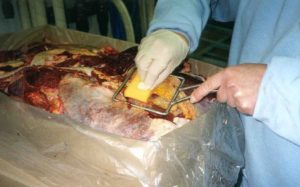Microbiological contamination
What are the main types of microbiological contamination found in a meatworks?
Moulds, virus and bacteria can all cause contamination of meat but bacteria are the main types of biological contamination in a meatworks.
What are bacteria?
Bacteria – sometimes called germs or bugs – are very small creatures which have only one cell. Six million bacteria could fit on a match head and they can live almost anywhere.
There are three types of bacteria:
Food poisoning bacteria
Bacteria is the most common cause of food poisoning. The chart over the page shows some of the bacteria associated with food poisoning caused by meat products. Bacteria, such as E. Coli, also produce toxins or poisons which remain on the meat. Cooking does not destroy the toxins. So you can get food poisoning by eating the bacteria or eating the toxins produced by the bacteria. You cannot see or smell food poisoning bacteria.
Food spoilage bacteria
These are the bacteria which turn meat green and slimy and produce that strong ‘off’ smell. They are a major factor in reducing the ‘shelf life’ of meat products.
Harmless bacteria
Some of these are used to make cheese and yoghurt. Other bacteria live in our stomach and help us to digest our food.

Both carton and carcase meat samples are tested to identify bacterial contamination.
